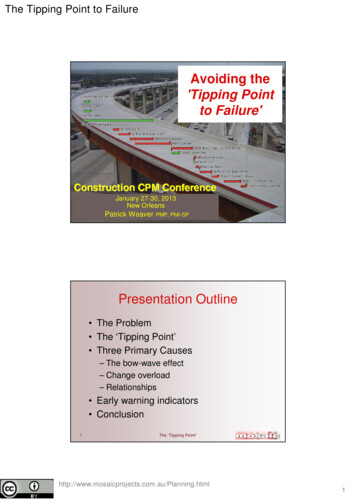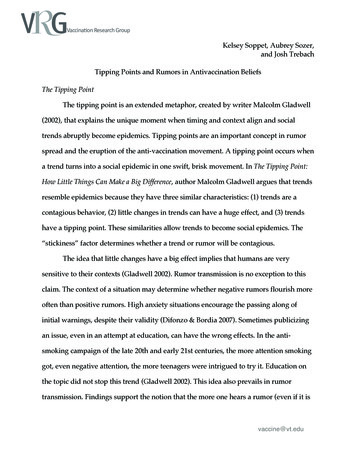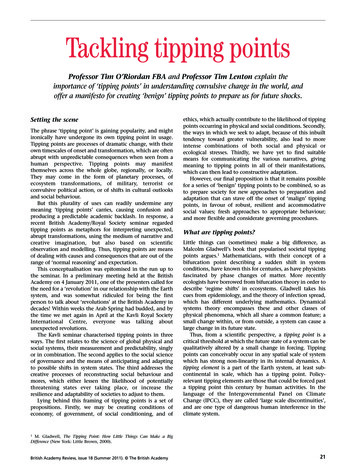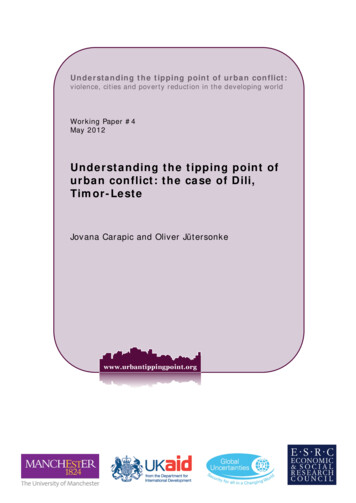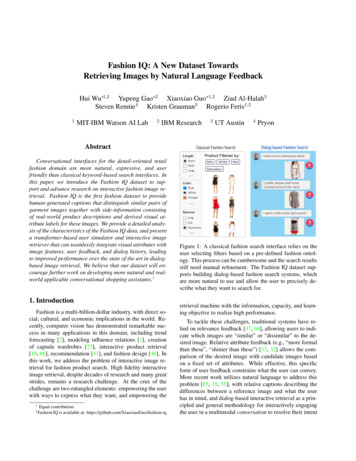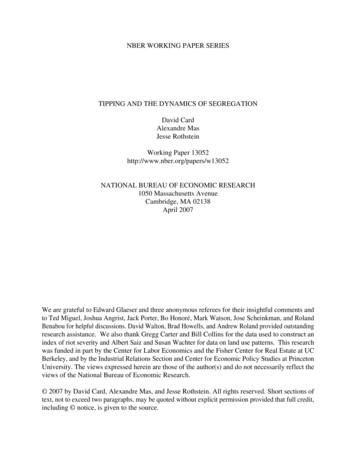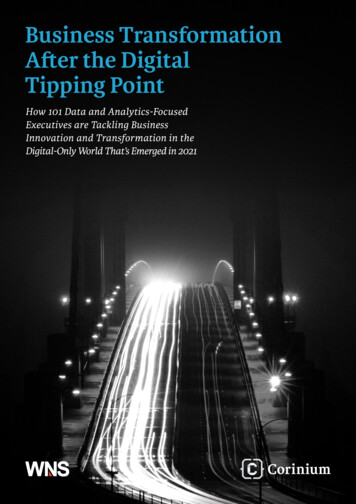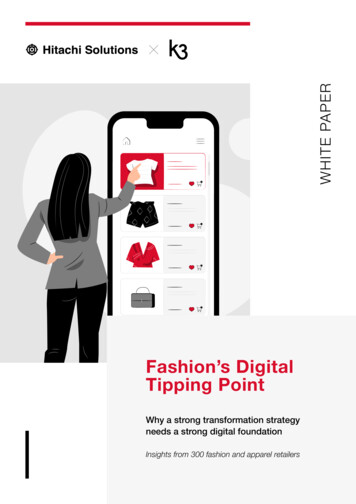
Transcription
WHITE PAPERFashion’s DigitalTipping PointWhy a strong transformation strategyneeds a strong digital foundationInsights from 300 fashion and apparel retailers
FASHION’S DIGITAL TIPPING POINT 2ContentsFashion’s digital tipping point5Adapting to new retail models6Sustainability through technology8Simplifying visibility10Conclusion11
FASHION’S DIGITAL TIPPING POINT 3Intro2020 provided a reset moment for retail and fashion,with many brands completely pivoting to meet customerdemands through digital channels.Fashion brands quickly turned their attention to theireCommerce capabilities. Reshaping existing operationsand IT systems to engage with customers online became atop priority, creating a fresh set of challenges. Our researchfound that the issues reported overwhelmingly lie within alack of visibility into operations and inventory: the return oninvestment from investments in digital channels is at riskbecause of antiquated transactional systems.Our study shows that a good digital strategy depends ona solid foundation, and for many that means reconsideringtheir ERP solution. For the uninitiated, an EnterpriseResource Planning (ERP) solution is technology thatprovides real-time views of stock and tracks and optimisesoperational processes such as procurement, distribution,replenishment, sales, and accounting.We are in the era of digital ERP. While previous decadessaw ERP integrations as an arduous and painful process,today the popularity of easily integrated cloud-basedsolutions continues to grow. The advent of specialisedsolutions has cut the complexity from the process,providing retailers with quicker time to value.In fact, according to our research, retailers that have madeinvestments in digital ERP earlier report fewer issues andare quicker to deploy efficient digital sales strategies.Essentially, the ability to access a single source of realtime data is a huge competitive advantage for fashionbrands in a world which increasingly values convenience,personalisation, and flexibility.I hope you enjoy the read!Jason ColbridgeRetail Business DirectorHitachi Solutions EuropeMethodologyIn Q2 of 2021, Hitachi Solutions and K3 BusinessTechnologies commissioned a survey of 300 Directors ofeCommerce, Finance, and Buying and Merchandising fromapparel and footwear brands with a turnover of over 100million euros. Respondents were split equally over thosebased in France, Germany and the UK.The survey was conducted by appointment over thetelephone and the results are presented here with analysisand commentary.
FASHION’S DIGITAL TIPPING POINT 4Key Stats86% say the #1 cause of internalbottlenecks is lack of visibility overoperations and inventoryThe greatest benefits of digitalisingERP are enabling growth (28%) andvisibility (20%)The top challenge to digitalising ERP ismaking the business case (28%)Early adopters of digital ERP are a thirdmore likely to have capitalised on theeCommerce boom45% of fashion retailers say they arebehind in their digital ERP journey81% believe ERP solutions can helpthe fashion industry become moresustainable58% of respondents say easyintegration is the most importantfeature in an ERP
FASHION’S DIGITAL TIPPING POINT 5Key FindingsWhere are you on your digital ERP journey?23%31%29%17%0%Our digital ERPstrategy is cuttingedgeWe’re ahead of thepackA bit behind but we’vestarted to digitaliseLagging behind,we have a plan buthaven’t startedNo immediate plansto digitalise, we don’tsee the valueDo you have one source of data for inventory and ERP processes?45%Yes40%Not yet but we areworking on itAround 1 in 5 fashion brands have yet to digitalise theirERP, with France being the slowest adopters and Germanythe quickest.Out of 300 respondents, there was not a single fashionexecutive who didn’t see value in digitalising ERP. Having onesource of data to connect operations in real-time is not onlybeneficial, but fundamental to a healthy business.Keeping track of operations and stock might not be the mostglamorous part of the fashion industry, but meeting customerdemands depends upon having that connected overview.Businesses who start with this as a foundation will have amuch easier time responding to issues, decreasing time tomarket, and pivoting to meet changing customer demands.Despite this, only 45% of respondents have one source ofERP data – the UK are lagging most with only 35%.16%No and we arenot working on itHowever, the fact that 40% of fashion brands are workingon a single source of ERP data is a good indication thatthe industry is about to move past a tipping point. As thepercentage of fashion brands with a digital ERP solutioncontinues to grow, it’s going to become more and moredifficult for brands who are still entrenched in disconnectedand time-consuming legacy systems to differentiatethemselves. This stat indicates the last call for retailers towake up and start acting on the customer demand thatthey’ve been leaving on the back burner.Key TakeawayLaying the foundations for a single source of real-time data isa competitive advantage for fashion brands in a world whichincreasingly values convenience, personalisation, andflexibility. Fashion brands need to meet customers wherethey are, and digital ERP solutions play a critical role here.
FASHION’S DIGITAL TIPPING POINT 6Adapting to new retail modelsWhat do you see as your key growth sales channels?Social Media71%B2B Ecommerce63%B2C Ecommerce60%Market Places50%International Markets45%Bricks & Motor Stores42%Fashion wholesaleRespondents were asked to select all that applyHas your budget for digitalising the following operations in 2021 increased or decreased?100 %80 %Increased60 %Same40 %Decreased20 %0%eCommerceMarketingSupplyChainCRMSocial is a key growth channel for all regions (France 65%,UK 79%, Ger 70%) – the UK also expects to see significantgrowth from B2C eCommerce (70%), and France from B2BeCommerce (70%) as well as marketplaces (56%).In terms of funding for digital, ERP has seen a thirddecrease this year, while eCommerce increased by 61%.It’s no surprise that eCommerce has absorbed much of thedigital budget with online sales figures surging.Last year, many brands pivoted completely to meet customersthrough digital channels. But it’s important to remember thata good eCommerce strategy depends on a solid foundation– which means creating a single view of inventory. Customersexpect a connected journey – from an Instagram ad to a clickand collect order, to the shop floor. Being able to track ordersand returns across channels is essential to this seamlessexperience.PLMMerchandising& PlanningERPCreating a connected ecosystem now will set fashion brandsup with agility in the long-term, as well as benefitting digitalstrategies in the short-term. As lockdowns ease and storesbegin to re-open, connecting these digital and physicalchannels will be a key differentiator for customers who havebecome used to seamless digital journeys.Key TakeawayConnecting channels with real-time data matters in the shortand long-term. While fashion brands are wise to be focusingon digital channels, retailers should not be too quick to cutfunding for ERP. It’s important to remember that withouta connected view of inventory and operations, the widerecosystem won’t be connected enough to provide a seamlesscustomer journey.
FASHION’S DIGITAL TIPPING POINT 7What is the greatest benefit to a digitalised ERP solution?Enabling growth28%Greater visability into.20%Quicker time-to-market16%Able to respond to.11%Frees up time10%Less human error7%Instant reporting7%The last year stress-tested retailer’s agility like never before,with customer behaviour changing overnight. And accordingto our research, 57% felt they weren’t agile enough tocapitalise on the eCommerce boom last year.Our research found that early adopters of digital ERPwere a third more likely to capitalise on the eCommerceboom, while digital ERP laggards weren’t agile enough.This suggests that pouring money into eCommerce aloneisn’t enough – fashion retailers need to build their digitalstrategies from the ground up, starting with a single sourceof data.Traditional processes and legacy software can severelyhinder an apparel company’s ability to react with agility tomarket trends. However, integrated ERP solutions with robustproduct development capabilities tailored to the fashionindustry can help standardise the pre-production processesand communications that prolong to time-to-market.Would you say your business was agileenough to fully adapt to and capitalise onthe boom in eCommerce last year?Indeed, our respondents said the greatest benefits ofdigitalising ERP are enabling growth (28%) and visibilityinto operations and inventory (20%).51 %29 %Quicker time-to-market was also a listed as a key benefitfor the fashion executives we surveyed, who know all toowell the importance of having the right product in the rightplace at the right time.14 %6%TotallyagreeAgreeDisagreeTotallydisagreeKey TakeawayConnecting channels with real-time data matters in the short and long-term. While fashion brands are wise to be focusing ondigital channels, retailers should not be too quick to cut funding for ERP. It’s important to remember that without a connectedview of inventory and operations, the wider ecosystem won’t be connected enough to provide a seamless customer journey.
FASHION’S DIGITAL TIPPING POINT 8Sustainability through technologyDo you believe digital ERP solutions can help with the push for sustainability in retail?19 %81 %NOYESHere’s what our respondents had to say FranceGermanyUK“Accuracy builds sustainability andERP is known to bring in accuracywithin most of the organizationalprocesses.”“Digital ERP solutions andsustainability go hand in hand.The solution is bound to bring ingood resource measurement andutilization.”“All modern solutions that aredigitized have an underlyingadvantage where sustainabilitycomes into the picture. If the rightsolution is used in the right manner,sustainability will make its waythrough.”“Accurate consumption, lesswastage will be prime outcomes ofERP solutions and this will certainlypush sustainability within theorganization.”“Reducing wastage is one of the firststeps of sustainability and ERP canprove to be vital in that regard.”“Digital ERP solutions will assessthe usage of resources well andderive methods to use themaccurately. This is an important stepin achieving sustainability.”“Wastage due to errors will beeliminated and operations willbecome accurate. Better decisions allrelating to sustainability will follow.”“Optimal asset management will leadto sustainability in the steadiest ofways.”
FASHION’S DIGITAL TIPPING POINT 9Recent research by K3 on 2,000 consumers found 30%had boycotted a brand last year for lack of environmentalawareness – and for 18-24 year old that number rises to astaggering 54%. On top of this, nearly half want to see morecircular initiatives from retailers.Customers are demanding more sustainable ways toshop – and 81% believe ERP solutions can help fashionbecome more sustainable. Tech is playing a huge role inretail’s move towards a more sustainable and transparentmodel. With Germany recently passing the Supply ChainAct, it’s likely that other countries will soon follow in placingthe responsibility of a transparent supply chain uponretailers.Ultimately, it’s up to the individual customer whether at-shirt with a hole in it goes in the landfill, gets recycled,or is used for something else. In that way, consumers aregatekeepers. In return, brands and retailers need to produceand sell products that can be repaired, reused, and recycled,and they need to make it easy for consumers to makesustainable choices.If they have all the information, and the solutions areattractive, transparent and convenient, it can be a reallysymbiotic relationship. Retailers have a role to play in guidingand educating, and they can see this as an opportunity tobuild customer loyalty.Key TakeawayCustomers are demanding more sustainable ways to shop.Technology is a powerful tool to trace provenance, and helpconsumers circulate products and give them a new life – buttransparency depends on having fully digitalised operations.ETUDE DE CASAdidasThe fashion industry accounts for around 10% of globalgreenhouse gas emissions. However, environmentalactivism has seen fast fashion taking a backseat, whilesales of second-hand clothing are set to grow 69%between 2019 and 2021.Adidas has partnered with Stuffstr, an app that can beintegrated on any retailers’ website to track the value ofa purchase over time and allows customers to sell backunwanted clothing for store credit.ETUDE DE CASRebecca MinkoffAfter several accounts in the fashion industry of hiddenmessages sewn into clothing by mistreated workers,retailers have been pressed to address issues ofprovenance and supply chain visibility.Rebecca Minkoff launched a spin-off brand LittleMinkoff that uses blockchain technology to ensure itsproducts are sustainably and ethically produced. Thetechnology tracks production of the childrenswearrange providing data-led oversight of the supplyand production chains. The brand can backtrack allmaterials as far as the fibres used to manufacture them.Crucially, all these processes are digitised meaningconsumers can trace the provenance of any single item.
FASHION’S DIGITAL TIPPING POINT 10Simplifying visibilityWhat is the biggest internal cause of bottlenecks?86%Lack of visibility toidentify bottlenecks13%Lack of agility to dealwith bottlenecks oncethey are identified1%ManualerrorsHere’s what our respondents had to say FranceGermanyUK“Being insightful is not alwayspossible because data comesin fragmented, and this causesbottlenecks in making quick andinformed decisions.”“Customer expectations changefaster now, and we have very littletime and limited visibility to developnew products and expect them toraise revenue.”“It’s the real time visibility of inventorythat causes most of the issues, butwe are getting there with better digitalsolutions.”“We cannot identify certain risksbecause there is no real-time visibilityfrom the data that we collect.”“Most of the bottlenecks are ininventory where lack of real-timeinsights has presented challengesand bottlenecks.”86% say the #1 cause of internal bottlenecks is lack ofvisibility into inventory and operations.It’s been estimated that acquiring new customers costsanywhere between 5 to 50 times as much as retainingexisting customers. Yet retail budgets consistently fail toreflect this truth. Furthermore, studies have found that anegative experience with a brand is a much more powerfuldecision maker than a positive one. Inconveniences like outof-stock products threaten a smooth customer journey andcould result in loss of loyal customers. If fashion brands trulyprioritise a cost-efficient customer retention model, then theymust devote more budget in order to avoid these negativeexperiences, rather than prioritising attempts to “wow anddelight” customers with positive experiences.“Analytical data hasn’t made its waythrough successfully and we haddelays in making business decisions.”“Lack of real-time visibility did lead usto over-stock as the demand droppedthis time last year.”Bottlenecks are poisonous to the seamless customer journey.And with very little margin for error, having enough visibility tosee and react to bottlenecks is critical. Fashion brands can’tafford to move forward with a fragmented view of their data,and risk negative experiences that drive loyal customers totheir competitors.Key TakeawayRetailers need to focus on retaining customers. Preventingbottlenecks that drive customers to competitors is a moreeffective use of budget than acquiring new customers.Visibility will be key in ensuring customer journeys areseamless – and retailers must use data analytics solutions toturn insights into actions.
FASHION’S DIGITAL TIPPING POINT 11Challenges to digitalisationWhile less than a fifth of respondents have most troublegetting support from the c-suite, building a business case(28%) has proven to be the most difficult hurdle. Ourresearch has already shown that fashion brands thrive ona solid digital foundation, and any business serious aboutmeeting customer demands in the long term is prioritising asingle view of their data.Complete digital overhauls can be costly, time intensive, andrisky. It’s important to account for the main concerns whenbuilding a business case, so we asked respondents what themost important features of a digital ERP are for them.The most important feature in an ERP is easyintegration (58%) and usability (56%) – integration isparticularly important in the UK (70%) – whereas in France,customisability is top priority (58%)It’s clear that a strong business case depends on findinga partner who can minimise the initial hurdles. Instead ofchanging to fit a new system, fashion brands need a solutionthat can build on their existing digital strategy. This means thatrather than relearning a new system, employees can expandon their existing knowledge.What is the biggest obstacle to digitalising ERP?26%28%17%13%13%3%Making thebusiness caseProvingROISupport fromthe C-SuiteFinding asolution thatintegrates easilyWe haven’thad the timeFinding the rightpartner who can takeus through this journeyWhat is the biggest internal cause of bottlenecks?Easy integration58%Easy to use56%Breadth of functionality53%Low cost51%Easy to customise50%Excellent support fromsolution provider29%Respondents were asked to select three optionsKey TakeawayFinding a solution that builds on your digital strategy will cut out initial hurdles. Implementing a solution that is dedicated to theFashion retail industry will save you time and money, make sure that your partner talks your language.
FASHION’S DIGITAL TIPPING POINT 12ConclusionInvestments have been oriented mainly towards eCommercedue to the COVID-19 crisis. However, a lack of visibility intooperations and inventory has been a spanner in the worksfor growth. Retailers must now think about the foundationsof their digital strategies by making sure that their ERPsolution is solid enough to support an efficient and agileomnichannel experience.While many fashion brands feel that their ERP strategy islagging, plenty of retailers are currently working on building asingle source of data to enable growth, visibility, and quickertime-to market. Fairly soon, this will be a non-negotiable forany fashion brand serious about meeting customers wherethey are.At a time when no fashion brand can afford to lose business,increasing visibility means avoiding the bottlenecks thatdrive customers to competitors who offer a more seamlessexperience.Investing in avoiding these negative experiences will increasecustomer retention in the short-term, while providing theagility to meet changing customer demands across channelsin the long-term. In fact, an overwhelming majority believedigital ERP will play a key role in implementing the circularand sustainable initiatives customers increasingly demand.And yet, despite a clear list of benefits, fashion executivesare still struggling to build the case for a more moderndigital ERP. The time intensive integrations and difficultycustomising and using software are major stumbling blocks –so it’s crucial that any solution brought to the table minimisesthese hurdles and strikes a balance between easy and agileimplementation over a shorter time frame, with a partner thathas specialist knowledge of fashion and apparel retail.About K3 fashionAbout Hitachi SolutionsHere at K3 we have been working closely with many fashionand apparel businesses and have developed an industrysolution which fits your needs.Hitachi Solutions understand what it takes to digitallytransform organisations, harnessing the powerof the latest technologies and seamlessly integrating theminto businesses. As a global consultancyfirm working across the private and public sectors, wespecialize in user-friendly businessapplications based on the Microsoft cloud.K3 fashion is a concept-to-consumer solution. Flexible andscalable, embedded in Microsoft Dynamics 365, and furtherenhanced to meet the unique and exacting needs of thefashion and apparel industry.Our solution offers fashion and apparel businesses atailored environment in which to gain insight and controlover all processes and channels to market. The customizedtools, pre-configured to align to specific fashion tasks andprocesses, drive agility and productivity.The out-of-the-box fashion functionality means no needfor extensive back-end configuration, resulting in a shorterimplementation cycle and quicker ROI.Turbocharge your ERP with K3 fashion.To find out more visitwww.k3btg.com/solutions/k3fashion/If you would like to find out more about K3 Fashion – aneasily integrated cloud-based solution, specialized for thefashion industry, get in contact today.Email: jcolbridge@hitachisolutions.comTel: 44 (0)203 198 5136
Tipping Point WHITE PAPER Why a strong transformation strategy needs a strong digital foundation Insights from 300 fashion and apparel retailers. FASHION'S DIGITAL TIPPING POINT 2 Contents Fashion's digital tipping point 5 6 8 10 11 Adapting to new retail models Sustainability through technology
